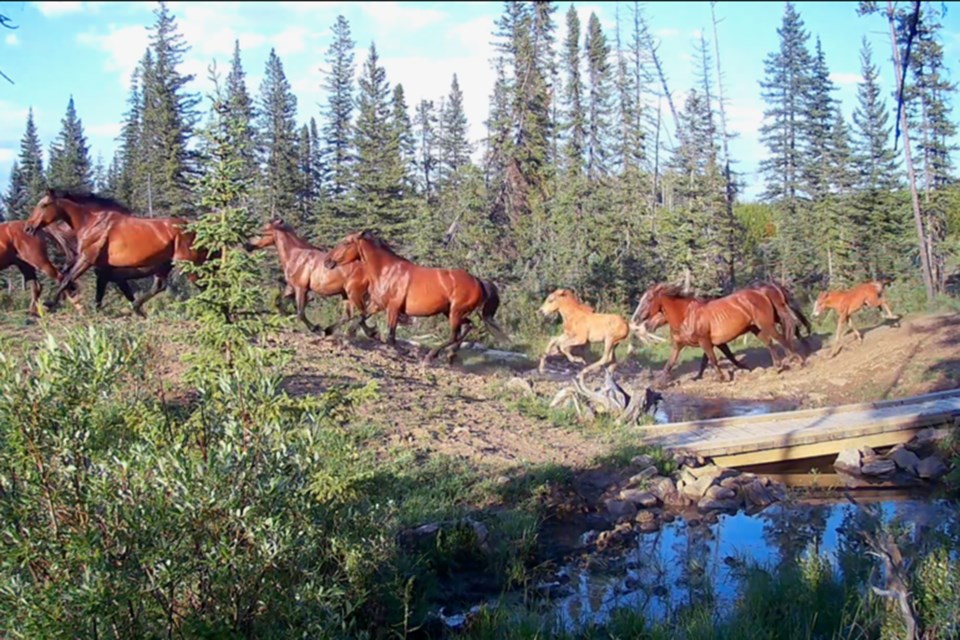Among vast meadows dotted with yellow flowers and sprawling evergreen trees, wild horses gallop freely in central Alberta, playfully fighting in the summer sun or grazing on grasses and shrubs with their equine buddies.
On a breezy day in June, two young stallions, chocolate-brown coats glistening, circle each other before jumping into the air and wrapping their front legs around each other’s neck. A lone white stallion disappears into a forested area nearby while other horses, in shades of grey, brown and black, blend into the rolling landscape.
But what these carefree creatures don’t know is that they are at the centre of a decade-long battle between a wild horse advocacy organization and the provincial government. At stake is the horses’ very existence.
Alberta argues it has to manage the wild horse population to prevent damage to its pasture land – it says the horses’ grazing habits contribute to ecological decline. The province has, in the past, ordered the cull of hundreds of horses.
Meanwhile, the Help Alberta Wildies Society (HAWS), which formed in 2014 to fight a government-sanctioned slaughter, assert the province’s concerns are overblown and that the population must be protected at all costs.
“Stirling, how you doing, bud?” says Darrell Glover, president of HAWS, as a majestic white horse runs past him in the Sundre Equine Management Zone. “Everybody thinks I’m crazy because I talk to the animals, but they understand tone, they understand softness and they understand kindness.”
These horses have roamed freely in the foothills of the Canadian Rockies for centuries with strong ties to Alberta’s Indigenous and farming communities. They are believed to be the descendants of escaped or released domestic horses used by hunters and in logging, mining and farming operations. Yet, they are not legally protected like other wild herds in Canada, such as the Sable Island National Park Reserve horses in Nova Scotia.
The highest concentration of wild horses in Alberta is in the Sundre area. The province estimated there were 969 horses in 2023, which is just shy of the 1,000-population threshold that triggers immediate action to reduce the herd size through adoption, contraception and, in extreme cases, killing. HAWS, which conducts its own aerial surveys, believes the government’s count is inflated.
Pam Davidson, press secretary for Forestry and Parks Minister Todd Loewen, said there is no cull currently “planned or anticipated” in Alberta. She said the government is adhering to guidelines in its Feral Horse Management Framework, which was developed by a committee that includes wilderness experts, Indigenous groups and academics. “Future committee meetings will include discussions on non-lethal methods of managing feral horses, including adoption and contraception,” said Ms. Davidson.
However, the framework notes that euthanasia will be considered a “last resort when all other options have been explored and are not viable as a means to lower the populations.” It also states that if rehabilitation for a horse that has been deemed unhealthy and unadoptable is not possible, then it will be euthanized.
Mr. Glover said Alberta’s wild horses are being made a scapegoat for damage to the landscape, despite evidence of harm being done by seasonal free-grazing cattle, the logging industry and campers. Driving a side-by-side over the bumpy landscape in Sundre, he stops frequently to prove his point.
There is damage to stream banks and native vegetation, abandoned shotgun shells and shooting targets on wooden sticks, mud pits and stripped grass from off-roading tracks. Cows and bears paw holes in the pasture, he explains, while horses flatten the grasses.
Alberta, in its framework, states that overuse and potential degradation of the land and forage by cattle, horses and other wildlife can “exceed what the land can sustain.” It notes that the decline of grassland ecosystems because of the intrusion of shrubs, invasive species and development significantly threatens biodiversity.
Mr. Glover said the government has failed to provide proof that horses are the culprit. He said he won’t stop fighting until the wild horses can live in harmony with other wildlife – and people.
“I’m not hopeful for it at this point, maybe not in my lifetime, but I have lots of people coming up behind me that will continue the drive,” he said. “I’m just an old dude trying to save the horses.”




